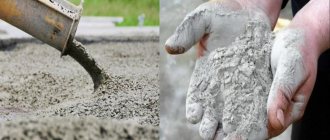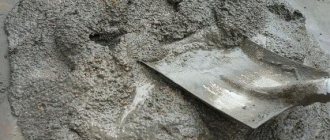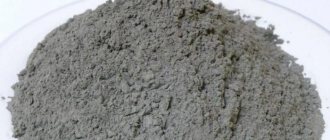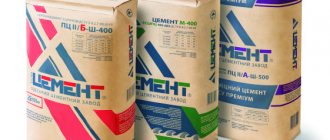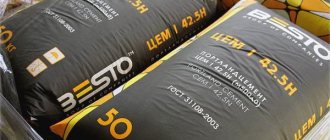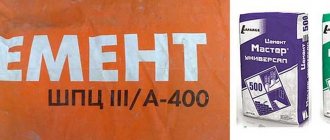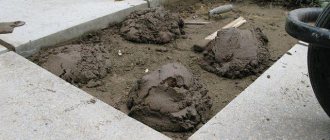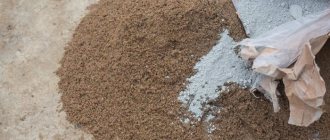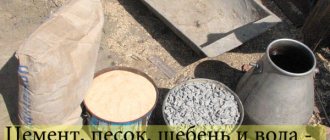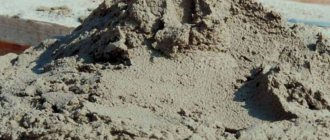Cement-sand mixture Stimul M300. Photo by Leroy Merlin
Cement is used in almost any construction and repair work. But in its pure form it is used very rarely. To solve various problems, solutions and mixtures of several types , differing in composition, and, accordingly, characteristics, scope of application, etc.
Types and areas of their use
Universal dry mixtures differ in composition and purpose, they have their own characteristics and characteristics.
You should pay attention to the marking, the number in which indicates the strength of the original product
M100
M100 products are intended for manual plastering and putty. The mixture is applied in an even thin layer, which leads to material savings. She is easy and pleasant to work with. The mixture retains its properties for two hours from the moment of dilution. Prices for M100 products are quite affordable.
M150
M150 products are the most popular of the varieties of universal mixtures. It is used in virtually all construction work using dry compounds. Unlike M300 and M400, it is used for masonry, plaster, and screed. Factory packaging is presented in 50 kg bags, less often they produce products in 25 kg packaging.
The universal mixture includes Portland cement, sand, mineral powder, plasticizers and other additives. The finished composition can only be diluted with cold water in the proportion indicated on the package.
M150 products are endowed with many advantages: they are reliable, frost-resistant, have good adhesion to various surfaces, high moisture resistance and vapor permeability. It is used in any climatic conditions.
The disadvantages of M150 include poor resistance to increased loads (no more than 150 kg per 1 cubic cm), therefore such a mixture is not used for work with the foundations of multi-story buildings.
The name “universal” speaks of the variety of applications of the M150 composition.
- The plaster mixture is designed for interior and exterior plastering work. Layer thickness can be applied up to 50 mm. After mixing, work should begin immediately: the mixture is in a pliable state for 2 hours. The plaster becomes completely dry and strong after 4 weeks.
- Using the M150 screed mixture, the floors in the rooms are leveled. Checking the level and setting the beacons, the floor is poured with a thickness of 1 to 10 cm. Thanks to the cement base, the floor acquires durable qualities that are resistant to temperature changes.
- The masonry mixture is used for laying gas silicate blocks and bricks of all types. M150 products can be used indoors and outdoors in cold or hot weather; weather conditions do not affect the quality of masonry. The dry mixture has proven itself well in rooms with high humidity.
M200
Product M200 is a masonry mixture. It consists of Portland cement, river sand and special additives. Designed for laying bricks, concreting flooring, constructing simple foundations, repairing walls and processing seams in concrete structures.
M200 can be used for laying garden tiles, as well as for plastering and puttying walls. It is available in bags weighing 50 kg.
M300
Sand concrete M300 appeared on the construction market not long ago, but has already gained popularity. Unlike the M150, it is designed for heavy loads. The products are durable and reliable, have a long service life, adapt well to weather conditions, are moisture resistant, environmentally friendly, and do not shrink. M300 consists of Portland cement, which contains gypsum, sand and crushed clinker. Products are packaged in 50 kg bags, less often in 200 kg bags for industrial scale.
Due to its special strength, the composition is used in all areas of construction work in all climatic conditions. During installation, they are used to install the foundation, floor screed, leveling walls and other surfaces. The product has proven itself well as a grout for cracks during work at emergency sites. The composition is used when laying garden paths, stairs, and borders. The mixture is used in the production of expanded clay concrete.
According to their properties, depending on the application, M300 products are divided into several subtypes.
- Coarse grain has incredible strength and long service life. With its help you can fill the foundations of high-rise buildings.
- Medium-grain is used for screeds, self-leveling floors, work with borders and garden paths. It is used wherever a medium-grained fraction of the mixture is required.
- Fine-grained is also reliable and durable; it is used for plastering work.
When choosing a universal dry composition, you should remember: the more famous the brand and the higher the grade of the product, the more expensive the product and the more reliable its technical properties.
For information on what dry building mixtures are, see the following video.
Marking
When purchasing DSPs to perform certain tasks, it is necessary to take into account that they have generally accepted markings that determine their properties and application features. The designation of compositions allows buyers to find out the compressive strength that the finished solution receives after hardening. Modern manufacturers produce the following grades of material:
- M100 - made with the addition of lime and contains a small amount of cement in relation to sand. Such mixtures can be used for plastering walls, leveling surfaces, and filling minor irregularities and defects.
- M150 is considered a universal mixture, widely used for installation, plastering and masonry work. In everyday life, this brand can replace any other. It is often used in floor screeds, adding fiber to increase strength properties. The recommended layer thickness when using M150 is 5–50 mm, consumption per square meter is about 16.5 kg. The finished mixture sets on average in 2 hours, its hardening time reaches 24 hours.
- M200 is an installation and masonry material characterized by a high content of Portland cement. The product is available in several modifications intended for plastering surfaces, making brickwork or pouring screed. A characteristic feature of M200 is increased strength. After preparing the solution, its average consumption for a layer 1 cm thick will be from 15 to 17 kg/m².
- M300 is a high-strength material for the manufacture of concrete. It is used for pouring foundations, creating massive screeds, and constructing partitions and walls. The mixture contains cement of at least grade M 400 and coarse sand up to 6 mm in size. Often when using this DSP, reinforcement reinforcement is used. The consumption of M300 during construction work is about 19 kg.
- M400 is the most durable mixture, suitable for the construction of foundations, the production of reinforced concrete products, and the installation of load-bearing structures. To make it, use Portland cement no lower than M500, which exceeds the amount of added sand in volumetric content.
There are other grades of material, selected depending on the needs of the master. For example, M500 can be used in private housing construction, while M600, M700 are prepared for special objects. These types of DSP are able to withstand increased loads and retain their original properties for a long time.
Specifications
The technical characteristics of sand concrete determine the rules of its operation and resistance to external destructive factors. The composition and technical properties of the M300 mixture make it possible to use it both as a self-leveling compound (self-leveling mixture) and as a repair composition.
Compound
Any variants of M300 mixtures are gray in color. Its shades may vary depending on the composition. For such materials, Portland cement M500 is used. In addition, the M300 mixture, according to GOST, has the following proportions of the main components: one third of cement, which is the binding ingredient, and two thirds of sand, which is the filler.
Frost resistance
This indicator indicates the ability of the material to withstand multiple temperature changes, alternating thawing and freezing without severe destruction and reduction in strength. Frost resistance allows the use of M300 sand concrete in unheated places (for example, in permanent garages).
Frost resistance of mixtures with special additives can be up to 400 cycles. Frost-resistant repair mixtures (MRMs) are used for mixing construction compounds used in the reconstruction and restoration of concrete, reinforced concrete, stone and other joints, filling voids, cracks, anchors and for other purposes.
Compressive strength
This indicator helps to understand what tensile strength a material has under static or dynamic influence on it. Exceeding this indicator has a detrimental effect on the material and leads to its deformation.
Dry mixture M300 can withstand compressive strength up to 30 MPa. In other words, given that 1 MPa is approximately 10 kg/cm2, the compressive strength of M300 is equal to 300 kg/cm2.
Temperature range
If the thermal conditions are observed at the time of work, the process technology is not disrupted. The continued preservation of all the performance qualities of concrete is also guaranteed.
It is recommended to carry out work with M300 sand concrete at temperatures from +5 to +25? C. However, sometimes builders are forced to violate these recommendations.
Adhesion
This indicator characterizes the ability of layers and materials to interact with each other. Sand concrete M300 is capable of forming reliable adhesion to the base layer, which is equal to 4 kg/cm2. This is a very good value for dry construction mixtures. To ensure maximum adhesive performance, manufacturers provide appropriate recommendations regarding preliminary preparation work.
Bulk density
This indicator means the density of the material in its uncompacted form, taking into account not only the volume of particles, but also the space that has arisen between them. This value is often used to calculate other parameters. In bags, the M300 dry mixture is in bulk with a density of 1500 kg/m3.
If we take this value into account, it is possible to draw up an optimal ratio for construction. For example, with the declared density, 1 ton of material is 0.67 m3 in volume
In small-scale construction work, a 10-liter bucket with a volume of 0.01 m3 and containing about 15 kg of dry mixture is used as a measure of the amount of material.
Sand particle size
Factories produce M300 sand concrete using sand of different fractions. These differences determine the peculiarities of the technique for working with the solution.
There are three main sizes of sand used as raw material for dry mixtures.
- Small size (up to 2.0 mm) – suitable for street plastering work, leveling seams.
- Medium size (from 0 to 2.2 mm) – used for screeds, tiles and borders.
- Large size (more than 2.2 mm) – used for pouring foundations and foundations.
Mixture consumption
This indicator characterizes the material consumption with a layer thickness of 10 mm per 1 m2. For M300 sand concrete it is usually in the range from 17 to 30 kg per m2. It is worth noting that the lower the consumption, the more economical the work costs will be. In addition, manufacturers often indicate the consumption of sand concrete in m3. In this case, its value will vary from 1.5 to 1.7 t/m3.
Delamination
This indicator characterizes the connection between the lower and upper parts of the solution. The M300 mixture usually has a delamination rate of no more than 5%. This value fully complies with the requirements of the standards.
What is sand concrete made of?
The characteristics of sand concrete m300 (composition, proportions 1 m³) are standardized by GOST 7473-94.
High-quality dry mixture contains:
- Portland cement PC500 D20/PTs400 D0;
- fractionated dry sand, with a combined composition of fractions (particle size 0.80-4.0 mm);
- other additives (frost-resistant, microsilica, fiberglass) are introduced at the discretion of the manufacturer.
Sand concrete M300 can be used to construct wear-resistant, high-strength floors as a load-bearing covering in utility and residential premises, including garages, basements (with a load of 250-300 kg/cm²)
Depending on the sand used, M300 grade material is used to carry out certain work:
| Sand, particle size, mm | Characteristic | Application |
| Small – 0.80-1.20 | High wear resistance and strength characteristics | Carrying out critical masonry and other external work, light floor screed 50.0 mm, installation solutions of increased strength |
| Average – 1.80-2.20 | Increased resistance to operating loads | Implementation of interior work, laying curbs, paving slabs, erection of Euro fences, screed up to 100 mm, “warm floor” systems |
| Large – 2.50-4.0 | Moderate moisture absorption | Construction of slab, strip and column foundations, plinths, pit floors, without restrictions on thickness using reinforcement |
Composition of sand concrete m200
The composition of sand concrete is determined by GOST 31357 - 2007 “Dry mixtures for construction with a cement binder”. Each manufacturer can make small additions to the composition of the mixture, but there are key components and indicators that are standard.
Main components:
- Cement m400;
- Sand;
- Crushed stone;
- Water.
When creating, Portland cement M400 is mainly used; it is one of the most common, and its technical characteristics meet all specified standards. Sand is used in two types of fractions - fine-grained and coarse-grained, thoroughly cleaned of foreign impurities.
The composition and proportions of sand concrete m200 per 1m3 according to construction standards, the mixture consumption is:
- Portland cement - 265 (1 part);
- sand 860 (2 parts);
- crushed stone 1050 (5 parts);
- water 180 (? parts).
Tips and tricks
When planning to prepare a cement-sand mixture, you must immediately decide in what proportion the different components will be taken, what grade of strength is needed, and what the main properties are.
It all depends on the scope of application of the mortar - so, if M50 or M75 is suitable for brickwork, then for screed prepare at least a mixture of M150, 200 and higher. The composition of any CPS includes cement, sand, water, but the result is different depending on the ratio.
Some tips from the experts:
- To prepare a plastic mixture, you can add liquid soap to the solution, previously thoroughly mixed with water.
- You need to know how to properly dilute cement and other components: first, all the dry substances are mixed, then water is added in small portions so that you can control the thickness of the mixture and achieve the ideal consistency.
- When preparing, take into account the brand of building material from which the walls are built. It is desirable that the parameters coincide - then the wall will have a homogeneous structure, reliable and durable.
- Before you make your own cement for plaster, you should take care of purchasing perlite. If you replace some of the sand with it, you will be able to achieve higher thermal insulation characteristics.
- For work, we use exclusively fresh cement, without lumps, produced according to technology and stored in optimal conditions - in this case, it will be possible to achieve the most uniform mixing and high adhesion.
- Detergent or soap is also added to the cement (the proportions remain the same, it is simply mixed with mixing water) to increase adhesion.
- The solution is best prepared in a container made of metal, plastic or wood.
- To thoroughly clean the sand from impurities that can reduce its strength, you can soak it in water for a short time.
- The consistency of the finished cement-sand mixture is usually checked with a trowel: the solution should be distributed evenly over the tool, but not run off (it is worth remembering that this rule works in the preparation of standard mixtures; for some tasks other properties may be important).
- The finished DSP is used for an hour after mixing, until the solution begins to thicken and harden. Therefore, you need to immediately prepare the required volume - exactly as much as you can produce in an hour.
- It is forbidden to dilute an already hardened solution with water, as it immediately loses its properties and can cause destruction of the structure/building.
- When mixing a mixture in a volume greater than 2 cubic meters, no drills or attachments will help - only a concrete mixer or ordering the required volume at the factory.
- The solution, which is planned to be used where minimal loads and low mass are noted, can be prepared with a reduced volume of sand. But this approach is only possible on the condition that before properly mixing the DSP, the master has precisely determined the specifics of the application and the remaining solution will not be used for the implementation of any other tasks.
- Mixing the cement-sand mass should last at least 20 minutes - this way the solution will be homogeneous and of high quality.
- The ratio of the proportions of the components is looked at in GOSTs and SNiPs (the opinion of experienced craftsmen is allowed), as well as in the recommendations of the manufacturer of cement, dry mix, etc.
Cement-sand mixture is a universal material that can be used to perform a whole range of works, obtaining the most durable and strong structures. Provided you select high-quality materials and follow the technology for preparing the mixture for the task at hand, everything can be accomplished quickly and easily.
Features of preparing TsPS
When preparing mixtures, it is important to pay special attention to their homogeneity. To achieve uniform mixing of the components, when using a concrete mixer, sand and cement are poured into water, and when mixing manually, the opposite is true. In the latter case, water is introduced into the dry mixture in portions, taking into account the selected ratio of components.
If modifiers or dyes are added to the mixture, they are poured dry. The resulting solution is kept for up to 15 minutes, mixed again and used for repair and construction purposes. Its viability is approximately an hour, so within the specified period you need to use up the entire prepared product. The consumption of cement-sand mixture depends on the type of work performed. In particular, to prepare 1 m³ of screed mortar you will need 9 50 kg bags of cement, 95 10 liter buckets of sand and approximately 200 liters of water.
DSPs greatly simplify the repair and construction of buildings. A wide variety of brands, compositions, and technical characteristics of the material satisfy the needs of every consumer. High-quality mixtures save time on preparing solutions and guarantee high results for a long time.
Peculiarities
Dry mix M-300 is a ready-made masonry mixture, the components of which are selected in the required proportions. Before use, the composition is diluted with water in the volume specified by the manufacturer and mixed mechanically until smooth.
The mixture is sand concrete, since it is based on purified fine-grained concrete and Portland cement. The dimensions of the first do not exceed 3 mm; the Portland cement used has a grade strength of M-400 or M-500). To ensure certain characteristics (frost resistance, moisture strength, and so on), plasticizers are introduced.
Various reinforcing fibers may be present in compositions operated at subzero temperatures. To improve adhesion, a special type of clay, coarse sand, or granite chips are sometimes added.
Unlike conventional concrete mortars, M-300 sand concrete is distinguished by its ease of preparation, plasticity (suitable for laying in a thin layer, which is necessary for certain types of masonry), high strength, and economical consumption. The M300 mixture is a masonry mixture, that is, it is used for fixing bricks or masonry stones. In addition, it can be used as a concrete mixture for casting.
The composition is characterized by non-shrinkage, which allows it to be used as a floor screed. And thanks to its increased strength and wear resistance, the mixture is used even when organizing high-strength floors. The thixotropy of the composition allows it to be used also for leveling floors, as well as sealing cracks in concrete surfaces.
The material is suitable for both private housing construction and the construction of industrial and administrative facilities, as well as the installation of basements and garages. It is used when pouring the foundation, including in places where concrete and reinforcing sections meet. The mixture is also used to create paths in private suburban areas. In its properties, the material resembles fine-grained concrete, therefore it is used both outside and indoors.
Types of dry solutions and mixtures
Before moving on to the types of solutions, you should define the concepts. Cement (or mortar) mortar is a mixture of cement (binder), sand (filler) and water. The term “cement mixtures” usually means a wide range of building materials: sand concrete, universal and assembly dry mixes, plasters and putties, etc. In addition to cement, the composition contains sand, additives and plasticizing substances. Mixtures are dry building materials , the use of which for their intended purpose requires mixing with water. You should also not confuse cement mortar and concrete. The second contains a coarse filler, which is most often crushed stone, often gravel.
Cement plaster. Photo by LafargeHolcim
Solutions can be classified into separate groups in accordance with several criteria. According to their intended purpose, mortars (and mixtures too) are divided into masonry, plastering, facing, for screeds and special ones, which have certain special properties: heat and fire resistant, cementing, heat and waterproofing, etc. In accordance with the type of binder(s) used There are simple and complex solutions . The first type includes mortars made on the basis of any one binder, for example, cement, gypsum, lime, etc. Complex ones are created on the basis of several binders, the most common being cement + lime. In accordance with the average density, it is possible to distinguish light and heavy solutions , demonstrating indicators of up to 1500 kg/cub.m. and 1500 or more, respectively.
Cement mixtures, in turn, are divided into fatty, normal and lean (lean) . The proportions of components in mixtures of the 1st type are 3 parts sand to 1 cement or less, 2nd - 4:1 and 3rd - 5:1. Fatty mixtures dry out faster, but are more susceptible to cracking. Depleted ones take a long time to dry and have low strength characteristics. Certain types of solutions and mixtures are of particularly high interest to Internet users.
Cement-sand mixture/CPS
The composition of any cement-based mortar, in addition to the binder, must also include other materials, primarily sand. The filler prevents the formation of cracks. The preparation and use of TsPS is regulated by GOST.
What is it, composition, what does it consist of
Cement-sand mixture (CSM) is a building material that contains cement and fractionated sand, as well as additives that improve individual characteristics of the mixtures. Portland cement or Portland slag cement grades M400 and M500 are used as a binder . Powdery bulk material, when mixed with water, forms a cement stone, the strength of which depends on the proportion of the components . To prepare the mixture, seeded quarry or river sand, washed and cleared of silty inclusions, . To impart individual characteristics to a solution or hardened coating, the following are added to the composition: plasticizers, hardening rate regulators, waterproofing additives, additives, and pigments.
Portland cement M500. Castorama Photos
It is possible to prepare DSP yourself or use ready-made factory-produced mixtures sold in dry form. Ready-made central fiber boards in bags reduce labor costs for preparing the mixture and guarantee the correct ratio of components, which ensures popularity among builders. Unlike ready-made mixtures produced in accordance with GOST, when mixing independently, it is impossible to obtain a mixture that is identical in composition and structure several times; each batch will be different from the previous one. Therefore, it is recommended to choose finished products.
Specifications
Cement-sand mortars have the following technical characteristics:
- Density _ For dry mixtures the parameter is about 2100 kg/cub.m. Indicators for solutions on dense aggregates classified as heavy vary from 1500 to 1800 kg/cub.m. The basis of light solutions are porous aggregates, their density does not exceed 1500 kg/cub.m.
- Coefficient of thermal conductivity . Cement-sand mortar has a fairly high thermal conductivity - 1.2 W/m*K.
Cement-sand mixture grade M150. Photo Petrovich
The following characteristics are typical for CPR after hardening and strength gain:
- resistance to temperature changes;
- frost resistance, the value of which depends on the brand;
- resistance to moisture is inherent in solutions of grade M150 and higher;
- good adhesion to brick, concrete and natural stone.
Types of mixtures with sand, according to
There are several criteria according to which it is possible to classify dry CFRP: purpose, percentage of cement, amount of binder components, density of the hardened mortar, strength, cost.
with appointment
In accordance with their purpose, dry mixtures are divided into compositions for:
Screed . They are produced on the basis of normal-hardening Portland cement M400 (CEM I 32.5N) or M500 (CEM I 42.5N) in proportions of 1 to 2 or 1 to 3, respectively. To fill the floor, the use of solutions of at least M150 grade is required. To reduce the likelihood of cracks forming, synthetic fiber fiber is added to the composition in an amount of 700-900 grams per cubic meter of the mixture. Cement-sand mortars are suitable for arranging screeds with a thickness of no more than 30 mm. If the indicator exceeds 30 mm, then a concrete mixture will be required.
Cement grade M500. Photo rossmesi.ru
Brick laying . When making mixtures, cement M400 or 500 and sand with grains no larger than 2.5 mm are used. For laying rubble stone, it is possible to use sand whose grain size reaches 5 mm. The proportions of cement and sand vary, from 1:3 to 1:5.
Plasters . The compositions are made on the basis of M200 or 300 cement. Plaster mixtures require the use of sand with a grain size of no more than 2.5 mm, for the formation of a covering layer - 1.25 mm. The proportions are 1 part cement and 3 sand.
It is important to remember that both homemade and ready-made fiber cement (!like cement) lose their properties during long-term storage. After 1 year, strength decreases by 50%. Open packaging contributes to loss of properties.
with percentage of cement
The percentage of cement allows you to divide mixtures into three types: fatty, normal and lean . The higher the binder content in the mixture, the faster the solution hardens. In greasy mixtures the sand to cement ratio is below 3:1. The disadvantage is the tendency to crack. To prevent the appearance of cracks in the production of fatty mixtures, high grade cement is used. In normal mixtures, 3-5 parts of sand require 1 part of cement . In lean mixtures, the ratio of sand to cement exceeds 5:1 . The mixtures harden slowly and tend to crumble over time . This problem can be avoided by using high grade cement.
with the number of binders
Cement in the composition of CPS plays the role of a binding component that reacts with water and ensures the formation of a solid monolith. But the composition may also include other binders: gypsum, lime and magnesium compounds.
Reference. Cement is a water-curing binder, while gypsum, lime and magnesium compounds are air-curing. Those. the first hardens when exposed to water, the rest - air.
Mixtures containing only cement are simple; adding one of the air-curing binders allows you to obtain complex compositions.
Cement-based mixtures have a number of advantages:
- suitable for indoor and outdoor work;
- provide a strong and durable coating;
- demonstrate low consumption when working with porous substrates;
- low cost compared to gypsum.
But there are also disadvantages: drying time, low decorative properties, difficulty in applying several layers.
Dry cement-sand mixture Mix Master universal M300. Photo by Maxidom
Mixtures with gypsum are characterized by the following advantages:
- plastic;
- quick drying;
- no shrinkage;
- light weight;
- vapor permeability;
- good decorative properties and susceptibility to finishing.
But gypsum mixtures also have disadvantages : low moisture resistance, and, accordingly, unsuitability for outdoor work, lower strength than its analogue, and high cost.
with density
According to density, light (no more than 1500 kg/cub.m.) and heavy (more than 1500 kg/cub.m.) are distinguished.
with cost
In accordance with the cost, it is customary to distinguish 3 types of DSP:
- Gartsovki are dry building mixtures of 2, rarely more, components. Depending on the number of components, prancers are divided into simple and complex mixtures. Simple, i.e. 2-component mixtures of binder (cement, gypsum, lime) and filler (sand, dolomite, expanded clay, marble flour). Complex ones include up to 5 components, for example, clay and gypsum are added to the standard DSP. The composition of the classic mixture is cement and quartz sand. The use of mixtures is quite extensive - from plastering to laying paving slabs.
- Mixtures with rheological additives that increase adhesion and water-retaining characteristics are used to prepare mortars for laying tiles and plastering.
- The most expensive are mixtures with surface additives , which are resistant to abrasion.
sand concrete M200, M300 and other grades, according to strength, application
The scope of application of DSP depends on the brand, which is designated by the letter “M” and demonstrates compressive strength . CPS grade M50 is used for finishing, filling cracks, eliminating small potholes and crevices; cement M300 or 400 can be used to obtain the mixture, the proportions are 1:5.8 or 1:7.4, respectively. TsPS M75 is suitable for performing rough work and plastering; it is used to level the surface and eliminate cracks, potholes, and chips. To prepare the mixture yourself, use cement M300, 400 or 500. The proportions of cement to sand are as follows: 1: 4.2; 1:5.4 or 1:6.7.
Sand concrete. Photo by LafargeHolcim
TsPS M100 are used in repair work, for plastering walls and ceilings, eliminating minor defects: potholes, cracks and crevices, fixing curbs, when creating an underlying layer for road surfaces, in landscape design. The use of M300 cement requires a ratio of binder to sand of 1 to 3.4; M400 - 1 to 4.3; M500 - 1 to 5.3. M50-100 mixtures are distinguished by the presence of lime in the composition, which is why the cement content is reduced.
Universal mixtures M150 are suitable for laying brick and stone, performing plastering and repair work, installing floor screeds, laying paving slabs, and sealing construction joints. To prepare CPS, cement M300, 400 or 500 is used, the proportions of cement:sand are 1:2.6; 1:3.25; 1:3,9.
M200 assembly and masonry mixtures are produced in various modifications to perform a wide range of work: preparing masonry and plaster mortars, for brickwork, pouring screeds, concreting floors and stairs, strengthening deteriorating surfaces, i.e. are used to solve the same problems as the M150, but in cases where increased loads are expected. The proportions of cement and sand in the manufacture of cement paste are 1:2.5 (for M400 cement) and 1:3 (M500).
CPS M300 (or sand concrete) is distinguished by increased strength and is used for concreting loaded areas: foundations, screeds, walls and floors. For preparation, it is necessary to use high quality cement, grade no lower than M400, river and quartz sand. The proportions for binder M400 are 1:2, M500 - 1:3. TsPS M400 is intended for load-bearing structures, construction of foundations of any type, production of reinforced concrete products.
additives mixed with sand
The composition of CPS may include various additives that impart special properties:
- plasticizers impart plasticity and mobility to the solution, reduce the water-cement ratio, minimize the formation of air bubbles and cracks, improve workability, increase the density of concrete, reduce shrinkage, and reduce the risk of cracks;
- hardening rate regulators , which accelerate or, conversely, slow down the hardening rate;
- waterproofing additives ensure increased water resistance of the hardened mortar;
- for frost resistance , which allows the use of mixtures when carrying out work in conditions of negative ambient temperatures;
- additives increase the mixture’s ability to retain water, which is necessary when working with water-absorbing surfaces: foam concrete, sand-lime brick;
- pigments are added to mixtures intended to solve decorative and functional problems prepared on the basis of white cement.
Benefits of use
The popularity of DSPs is due to the advantages of their use. When talking about advantages, it is customary to mean the use of dry mixtures produced in factories . They have a precisely selected composition and strict dosage of components . The accuracy of the recipe is ensured by the use of special equipment; automated lines guarantee dosage accuracy. The quality of the components used is confirmed through laboratory tests. Commercially available DSPs provide a number of advantages:
- reducing labor costs for preparing the solution;
- ease of preparation, no need to calculate the number of components;
- the presence of additional additives ensures the necessary properties of the solution and the finished monolith.
Cement-sand mixture (CPS) M150 Petrolite. Photo Petrovich
The disadvantage of a ready-made DSP is its higher price compared to the cost of separately sold components.
Proportions for different tasks
When preparing the mixture yourself, you must remember to maintain the proportions, which is a prerequisite for successful completion of the work. Preparation of the mixture for screed requires a proportion of 1 to 3. It is recommended to add fiber fiber in the amount of 800 grams per cubic meter to 1 part of M500 cement and 3 parts of sand. For bricklaying, use 1 part M400 or M500 cement and 4 parts sand. Preparing masonry mixtures requires paying attention to the cleanliness of the sand. If there are foreign inclusions, the sand must be sifted. Only then is it possible to obtain a mixture with a uniform consistency that allows the bricks to be securely fixed. For plastering, proportions of 1 to 3 are used.
Consumption
Cement M500. PhotoRoscement
An important characteristic during execution is the mixture consumption. The manufacturer indicates the consumption and recommended layer thickness on the DSP packaging; the indicator is measured in kg. per 1 sq.m. The value of the indicator is influenced by the size of the fractions and the nature of the work . The average consumption for a floor screed 1 cm thick is 15-17 kg. per 1 sq.m., when applied to walls the figure exceeds 17 kg. Calculating the amount of mortar for certain work, for example, brickwork or repairs, is quite difficult, especially if you lack experience. Therefore, it is recommended to mix the solution in small portions . It is possible to provide approximate values for the consumption of components for solving certain problems. For example:
- To install a floor screed you will need a bag of M500 cement weighing 50 kg, 15 10-liter buckets of sand and 4 10-liter buckets of water. For 1 cubic meter you will need 9 bags of binder, 95 buckets of sand and 20 water;
- for laying bricks you need one 50 kg bag of cement. mix with 16 10-liter buckets of sand and 4 10-liter buckets of water. For 1 cubic meter you need to mix 6 bags of cement with 96 10-liter buckets of sand and 23 10-liter buckets of water;
- To prepare plaster you need one 50 kg bag of M400 cement. mix with 27.5 10-liter buckets of sand and 4 10-liter buckets of water. Be sure to add lime in the proportion of 1 bucket of lime to 1 bucket of cement. For 1 cubic meter you need 7 bags of cement, 192.5 10-liter buckets of sand and 24 10-liter buckets of water.
Self-production technology, how to make
Self-preparation of cement-sand mortar can be done manually or using a concrete mixer. For manual mixing, you need a container into which the dry ingredients are poured and mixed until a homogeneous mass is obtained, after which water is added. Stirring continues until a solution with the consistency of thick sour cream is formed. To prepare a significant volume of solution, it is recommended to use a concrete mixer. The mixing procedure is as follows:
- 0.5-0.7 of the planned volume of water is poured into the concrete mixer;
- liquid additives are added, the components are mixed;
- a full portion of cement and approximately half the amount of sand are loaded, the components are mixed;
- the remaining sand is loaded, the components are mixed, water is added until the product of the required consistency is obtained.
Cement-lime mortar
Cement-lime mortar refers to complex materials, which contain two binder components . The solutions include cement, clean sand, sifted quarry sand is suitable, slaked lime and water. Cement is a water-curing binder, while lime is an air-curing binder. Lime reduces the cost of mortar and acts as a plasticizer, increasing workability. In addition to the main components, it is possible to introduce special additives into the composition: plasticizers, fiberglass, antifreeze additives, hybrophobic agents.
Superplasticizer CemPlast. Photo by Maxidom
Lime-cement mortar is a special building material characterized by increased strength and elasticity. It can be used as a masonry composition, as a basis for plaster when carrying out interior and exterior finishing work, when pouring monolithic floors, because lime increases strength and increases hardening time.
Advantages and disadvantages of the mixture
Cement-lime mortars have excellent adhesion to any surface , including concrete and wood, they fill all cracks and depressions and ensure reliable fixation. The bactericidal properties of lime eliminate the possibility of mold or mildew. The solutions can withstand temperature changes from -50 to +65 degrees Celsius. Strength and moisture resistance ensure the successful use of solutions without humidity and temperature restrictions. They are suitable for work indoors, including those with high levels of humidity, such as bathrooms, and for outdoor work. Prolonged drying minimizes the formation of cracks, but requires more time to complete the work.
Technical characteristics and properties
Cement-lime mortars are characterized by the following properties:
- the dry mixture is gray in color;
- mobility;
- resistance to water exceeds 90%; With
- degree of delamination up to 10%;
- average density;
- frost resistance does not exceed 50 freezing and thawing cycles;
- water consumption per 1 kg. the mixture varies between 150-400 ml.
Types and brands
Depending on the fat content, there are 3 groups of solutions:
- normal , with universal plasticity; free from shrinkage and cracking problems;
- skinny ones are characterized by minimal shrinkage and can be used for any cladding activities;
- fatty - highly plastic compositions with a significant content of binder components, used for laying bricks and other block materials.
The characteristics depend on the proportions of the components. To obtain a lean composition, more sand is added to the composition; for a fat composition, more lime is added.
Cement-lime plaster MixMaster. Photo Petrovich
Solutions differ in density: low (up to 1500 kg/cub.m) and heavy (from 1500).
Depending on the proportions of the components, solutions are divided into grades . M50 brand solutions are popular, which are most often used for plastering work; they are easy to prepare and affordable. M75 solutions provide reliable compositions for bricklaying. M75 and M100 are used in the construction of civil and industrial facilities.
Finished product or DIY
Lime-cement mortar has a lower price than CSP. The advantages of using ready-made lime mixtures for preparing solutions were presented above. Despite a number of advantages, Internet users continue to be interested in the issue of making their own solutions . For mixing you will need sand, lime and cement . The proportions of the components depend on the brand of the mixture that needs to be obtained.
Cement. Photo Asia Cement
To prepare the M75 solution , you need to mix the components in proportions - 1 part M500 cement, 0.8 lime and 7 sand or 1: 0.5: 5.5 when using M400 binder or 1: 0.3: 4 if M300 cement is used. To mix M50, you will need Portland cement M300 or 400, the proportions are 1:0.6:6 or 1:0.9:8. To prepare M100, it is possible to use three grades of cement: M300, 400 or 500, proportions - 1:0.2:3.5, 1:0.4:4.5 or 1:0.5:5.5. To mix the mixture, most often no more than 0.8 parts of water per 1 part of cement is required. It is necessary to obtain a solution with a consistency similar to thick sour cream.
Before mixing, it is necessary to slak the lime. Otherwise, bubbles will appear in the solution. A separate container is required for extinguishing. The technology depends on the type of lime , which can be fast, medium and slow. In the first case, powder is poured into a container with water. After the start of the chemical reaction, water is added and the components are mixed. The extinguishing process will take 8 minutes. It will take 25-30 minutes to extinguish medium-slaking lime. Slow-slaking lime is not poured with water, but rather sprinkled. Quenching is carried out until the volume increases 3 times.
To obtain a significant amount of solution, it is recommended to use a concrete mixer , which will allow you to obtain a homogeneous composition. Water is poured into the concrete mixer, cement, lime and sand are poured. After mixing the components, water is added again and the solution is brought to the desired consistency. When mixing by hand, it is recommended to use a drill with a mixer attachment. There are 2 kneading technologies:
- Slaked lime is filtered through a sieve with cells with a diameter of no more than 3 mm. Sand and cement are poured into lime milk. The components are mixed, the mixture is brought to the desired degree of fat content.
- Dry sand and cement are mixed. Strained slaked lime is poured into the dry mixture. Using water, the solution is brought to the desired consistency.
And sawdust
A mixture based on cement and sawdust serves as the basis for the industrial and independent production of sawdust concrete blocks ; the advantages and features of products of this type were discussed in a separate article. Blocks are used to form the walls of various rooms. In addition, mortars made from cement, sawdust and sand are used to create floor coverings. Using sand avoids shrinkage. The quality of the solution depends on the brand of cement, each requiring its own proportions:
- when using M400 binder, 1 part cement and 4 parts sand are required;
- M500, proportions are 1 to 5.
Water is added in small portions. To ensure plasticity, a plasticizer or detergent or powder should be added to the composition.
With expanded clay
Expanded clay concrete is a building material containing, in addition to cement, expanded clay, which is obtained by mixing cement, sand and filler in water in proportions of approximately 1:2:3. Expanded clay is used as a filler instead of traditional crushed stone, which is the main feature from conventional construction concrete. The composition also contains air-entraining additives . Expanded clay is a porous material based on baked clay, light in weight, an excellent insulator against excess noise, and retains heat. As a result , expanded clay concrete has the following advantages:
- low thermal conductivity;
- high heat and sound insulation;
- resistance to aggressive chemical environments;
- excellent tolerance to low temperatures;
- fire safety.
Expanded clay fraction 5-10. Photo by Maxidom
According to strength, there are several grades of expanded clay concrete:
- M50 and 75 are used in the construction of interior partitions and external heat-insulating walls;
- M100 is most in demand when installing floor screeds;
- M150 is used in the production of lightweight wall panels and blocks;
- M200 is used for the production of wall blocks and light basement floors;
- M300 , the highest grade, is characterized by increased strength characteristics; expanded clay concrete is suitable for the construction of load-bearing walls and foundation construction.
In addition, expanded clay concrete is classified into structural, structural-insulating and used for thermal insulation purposes.
Cement M400. Photo Asia Cement
Expanded clay concrete is used to solve a wide range of construction problems . Environmental friendliness, resistance to temperature and chemical influences, lightness ensure demand. Expanded clay concrete is used to produce wall panels and blocks for the construction of residential buildings. Blocks are divided into empty and solid. Solid blocks have greater strength than hollow ones, but their thermal insulation qualities are lower. The shape of the cavities can be slotted, finely slotted, rectangular, cylindrical.
The properties of expanded clay concrete make it a popular material for the construction of cottages and low-rise buildings . It is often used in the construction of baths. It is used for arranging heat-insulating layers, floor screeds, and forming interior partitions.
The composition of the mixture for expanded clay concrete depends on the type of material. The standard mixture proportions are 1 part cement, 2 sand, 5 expanded clay and 1 water. For the production of blocks , the following proportions are recommended: 1 part of sand is mixed with 2-3 parts of sand, the components are mixed, water is added (0.9-1 part), the composition is mixed again, 5-6 parts of expanded clay are added. For arranging a wet screed, it is recommended to use 1 part cement, 1 water, 3 sand and 2 expanded clay. The mixture for walls contains 1 part binder, 1.5 parts expanded clay sand, the particle size of which does not exceed 5 mm, 1 part fine expanded clay. For a warm screed you will need 1 part binder, 3 sand, 4 expanded expanded clay and 1 water. For floors, the following “recipe” is used - 1 part cement, 3-4 sand, 4-5 expanded clay and 1.5 water. It is necessary to use cement of a grade not lower than M400. The use of quartz sand helps to increase elasticity.
Plaster
Cement is the basis of a large number of mortars for installation and finishing work. Gypsum is also used in the manufacture of building mixtures, most often plaster. Cement mortars require a long time to gain strength , while gypsum hardens quickly . Therefore, many performers are thinking about combining two materials to obtain a composition that is easy to install .
During the production of cement, gypsum is added to all types of mixtures, which prevents the solution from quickly setting. But the amount of gypsum does not exceed 6%. Some unscrupulous craftsmen add gypsum (or alabaster) to the DSP to obtain a universal solution that is well applied in a thick layer and allows you to eliminate noticeable surface defects. But doing this is strictly not recommended .
Gypsum. Photo Petrovich
When mixed with water, the aluminate components of cement react with gypsum, which leads to the formation of ettringite - calcium hydrosulfoaluminate, the appearance of which is called “cement bacillus”. The increase in strength of the solution is accompanied by a significant increase in crystals in volume, which leads to the destruction of the cement stone ; it is impossible to resist this process. Thus, a coating made of DSP with gypsum will quickly, within 1-5 days, become covered with microcracks. The service life of such coating depends on the conditions, but does not exceed 5 years.
And polystyrene foam
Concrete with foam chips, which is often called polystyrene concrete (although polystyrene foam and polystyrene are different materials), is a building material made from cement, foam balls, quartz sand, and various additives. Has the following advantages:
- Lightens the weight of the structure;
- increases heat and sound insulation, which allows you to save on finishing;
- easy to make.
Cement M500. Photo SebryakovCement
But there are many more disadvantages, which is why the material did not gain popularity:
- polystyrene foam has a fairly soft structure, its service life is significantly shorter than that of concrete, which shortens the service life of the entire structure;
- foam concrete requires insulation from exposure to air and moisture, otherwise it quickly collapses;
- strong heating leads to the melting of the foam and the release of toxic fumes.
As a result, the scope of application of foam concrete is limited . Most often used for pouring floors in commercial buildings, installing screeds on the 2nd floors of buildings with weak floors.
To prepare the solution yourself, you will need foam chips, which can be purchased ready-made, in the form of granules, or the foam can be crushed in a crusher. The second option is more profitable from a financial point of view. Component proportions : 1 part cement, 1 water, 2 sand and 4 foam. For preparation, it is recommended to choose M500 brand binder. The preparation technology does not differ from the classical one; it is recommended to use a concrete mixer. The sequence of work is as follows:
- Cement and sand are loaded into the concrete mixer;
- foam granules are added;
- the components are mixed and water is added, the mixture is mixed again until a homogeneous consistency is obtained.
Asbestos-cement, with asbestos
Asbestos-cement mortar is a building material that contains dry cement of a grade not lower than M400, asbestos fibers and water, sand is not used. The proportions may vary , but most often they are 1 part binder and 4 asbestos . The solution is resistant to high humidity and low temperatures, stretching and fire, and plasticity. Solutions are used as an insulating crust for walls and other surfaces, which, thanks to the treatment, retain heat and are resistant to moisture. In addition, asbestos fibers ensure a smooth surface and subsequent plastering does not lead to the formation of cracks . Not used in civil engineering. In metallurgy, they are used as a refractory mass to prevent burnout of equipment. They are used for thermal insulation of boiler equipment , ventilation ducts and pipelines, when strengthening joints of asbestos-cement pipes, as a filler when laying cast-iron sewer pipes to give elasticity to the joints.
With limestone
Limestone is used as an additive in the industrial cement production process. The marking of cement with limestone contains the following information “ CEM II/A-I ”. Limestone is an inert mineral component , the amount of which in the production of binder is limited to 15-16%. The main functions are to optimize the granulometric composition of the binder, compact the structure and reduce the voids of the cement stone, which helps to increase the initial strength of concrete . The water-holding capacity of limestone ensures a reduction in the water separation of cement, which contributes to the creation of more homogeneous and, accordingly, high-quality mortars and concrete mixtures. Limestone improves the workability and plasticity of mixtures. Cements containing limestone are produced by many manufacturers, in particular LafargeHolcim.
Cement with limestone was used to make tiles. Photo by LafargeHolcim
With liquid glass: proportions for a well and more
Liquid glass, which is a viscous compound, is used as an additive for various building mixtures. Compounds based on sodium (Na2O(SiO2)n) and potassium (K2O(SiO2)n) are used. Potassium compounds are sold at higher prices, so they are used mainly in the production of paints and varnishes. Sodium is cheaper, has a pronounced astringent property, therefore it is used for adding to concrete and cement mortars. It is important to remember that liquid glass, regardless of its type, accelerates the hardening of the solution . Liquid glass and cement give the finished material useful properties : antiseptic, hydrophobic, acid-resistant and fire-retardant. They are used to ensure the resistance of the coating to acid and mechanical influences. And:
- Providing additional waterproofing , liquid glass is added to concrete before pouring. Waterproofing can also be performed by applying liquid glass or cement mortar with liquid glass to the surface of the wells,
- storm drains, hydraulic structures, septic tanks, etc.
- Increasing acid and fire resistance , the surface is primed with a cement mortar based on liquid glass with water.
- Sodium liquid glass can be added to the masonry mixture , which is important when creating brick stoves and fireplaces.
- Bonding materials: cardboard, glass, porcelain.
- Strengthening weak concrete and plastered surfaces.
- Antiseptic treatment of wooden structures.
Liquid glass, 3.5 kg. Photo by Leroy Merlin
When solving different problems, the proportions of the components differ:
- Filling voids and cracks in partitions and walls - liquid glass, cement and sand in proportions 1:1:3, the amount of water (by weight) does not exceed 25% of the amount of liquid glass.
- Priming the surface of the screed - 1 part cement and 1 liquid glass. Cement is mixed with water, the amount of which by weight does not exceed 25% of the amount of glass. Add the mixture of binder and water into the liquid glass, stirring constantly.
- Waterproofing of wells is carried out by coating the walls of the structure with liquid glass, and then with a solution of cement, glass and sifted fine sand in proportions 1:1:1.
- Preparation of concrete with water-repellent characteristics, masonry mortar with fire-resistant properties and finishing mixture. The share of liquid glass does not exceed 3% of the mass of the batch.
General information
A characteristic feature of concrete is its composition, as well as proportions and preparation technology. It consists of cement, fine and coarse fillers, water and various additives. In addition, there are brands of concrete that do not contain coarse filler. There are different mixtures that are used for specific cases and also have different properties.
Designation and its interpretation
Concrete structures gain full strength within 6 months, and in 30 days concrete gains 70% strength. M300 is used in all structures that are subject to significant load, therefore, one of the main indicators is its strength. The MXXX designation template does not indicate a specific brand, but is an indicator of the maximum compression pressure.
In addition, there are other designation patterns, for example, FXXX and WXXX, indicating frost resistance and water resistance, respectively. The M300 class of concrete shows the totality of all grades whose ultimate strength is 300 kgf/sq.m. cm. The tensile strength is tested in laboratory conditions by applying force to parallel planes of a product cast from concrete, in the shape of a cube with a side of 150 mm. The grade of concrete in terms of strength is correlated with its class. These indicators should be selected for the construction and calculation of the finished structure at the maximum load that it can withstand.
M300 corresponds to class B22.5 with a coefficient of variation (CV) that is 13.5%. It shows the homogeneity of the mixture from which any brand of concrete is made. When this coefficient changes, the grade of concrete will also change, that is, if its value is low, the grade will increase and vice versa. If the concrete is M300, then with different values of the coefficient its class will change:
- At Kv = 5% the class is B25.
- At Kv = 13.5% - B22.5.
- At Kv = 18% - B15.
Main characteristics
Concrete is classified into grades, and this distribution is primarily related to the parameters of strength (B), density (D), water resistance (W), frost resistance (F) and workability (P). One of the best options for most construction work is M300 concrete, the characteristics of which are as follows:
- Strength: B22.5 with an indicator of 295 kg/sq. cm.
- Specific gravity of concrete M300: 1800−2500 kg/cubic. m.
- Water resistance: W6-W8.
- Frost resistance: F200-F300.
- Mobility: P2-P4.
The strength indicator is the main characteristic and shows the maximum effect of forces during compression, at which the structure collapses. The specific gravity or density of M300 concrete depends on the type of coarse filler included in its composition. When using limestone, the D value is about 1800 kg/m3. m., and when using harder rocks (crushed granite, granodirite, etc.) it can reach a value of 2500 kg/cubic. m. Due to its high density, this type is classified as heavy. The density indicator depends on the presence of violations in the manufacturing technology and air cavities.
Water resistance (WXX) is a value indicating the water pressure in MPa to pass through 0.15 m of concrete. For concrete grade M300, this indicator is equal to W5-W6; at a pressure of 0.5-0.6 MPa (approximately corresponding to 5-6 atmospheres) it does not allow water to pass through at all. By adding hydrophobic cement, additives and carefully compacting the solution, it is possible to increase the waterproof rating.
Frost resistance is indicated in the form of the FXXX pattern and shows the number of defrost-freeze cycles without loss of strength. This characteristic can be increased in several ways:
- The use of additives that prevent the formation of air bubbles.
- Removing air from the concrete mixture using vibrators, as well as using various compactors.
- Reducing the amount of water (impairs mobility).
- Using solid fillers instead of crushed limestone.
Application in construction
Since M300 has good strength, frost resistance, water resistance and mobility, it is widely used in construction. In addition, its main indicators can be adjusted by changing the components included in the concrete mixture. It is advisable to use it for the following work:
- Construction of platforms, roads and curbs.
- Installation of walls and various supports.
- Construction of stairs, landings and pouring of foundations in multi-storey buildings.
- Production of reinforced concrete products and fences.
- Production of sewer pipes that are constantly exposed to moisture.
- Construction of objects that are affected by constant temperature changes.
How to prepare TsPS?
Each ready-made mixture must be accompanied by instructions on the required amount of water; other components are usually not provided. When used as part of additional materials (dyes, reinforcing fibers), the proportions must be observed strictly in accordance with the instructions for the additive. The typical ratio of mixture to water is 5 to 1 (a bucket of water per 50 kg bag of mixture), the share of dyes is 0.1%, the share of fiber fiber is 1%.
When making it yourself, the proportions of water and sand to cement are taken depending on the type of work being carried out, strength requirements, and the degree of moisture content of the sand:
1. The thickest mortar required for masonry is the water/cement ratio of no more than 0.8.
2. For screed and plaster, sour cream-like compositions with a W/C ratio of 0.8–1.2 are used.
3. When spraying and grouting, dilute the solution even more, up to W/C - 1.5.
4. Mixtures with W/C less than 0.6 are used when it is necessary to obtain a quick-drying high-grade cement-sand mortar (M300 and higher), or for concrete.
If a concrete mixer is used for mixing, it is recommended to carry out the work in the following order:
- Pour water into the untwisted drum and add additives.
- Add 2 buckets of sand.
- Add a bucket of cement and wait for it to mix.
- Add the remaining sand and add water if necessary.
When kneading by hand, water is poured into the dry mixture. If you do the opposite, water forms a film of cement on the surface of small lumps of the mixture, which will slow down the process many times over. If the composition is made from its own components, it is advisable to mix them dry before adding water.
Once prepared, the solution must be used before it begins to harden - from 15 minutes to several hours, depending on the use of additives, cement concentration and temperature. The usual solution M150-M200 at a temperature of 20 ° C begins to harden an hour after mixing.
Consumption
To plan the mass of the CPS in advance, you need to approximately calculate the required volume of solution and multiply it by the cost per 1 m3 indicated in the description of the mixture. Most often they are indicated in the format “mixture consumption per m2”, meaning a layer 1 cm thick. To get the costs per 1 m3, just multiply the indicated value by 100.
The usual consumption values for sand-cement mixture are 1800 kg/m3, for high-quality compositions - up to 2200 kg/m3, for lightweight plasters with lime - 1200-1600 kg/m3.
Calculating the volume of consumption of mortar for plastering work and screed is not particularly difficult, but the cost of material for masonry depends on the skill of the particular performer. If you strictly follow the technology, the solution consumption will be 25% of the total volume of the wall, but in practice this value can be either up to 35% (thick seams, losses due to splashes) or below 20% (waste masonry, use of poor-quality techniques to speed up work ).
Classification of cement-sand mixtures
Cement-sand mixtures are classified according to a wide range of characteristics. Depending on the percentage of cement they are:
- Fat – the ratio of fractional sand is less than 3 to 1. The disadvantage of this composition is cracking of the prepared concrete. To avoid the appearance of cracks, high-quality cement is used to prepare solutions.
- Normal - when mixing solutions, take 3-5 parts of sand to one part of cement.
- Skinny - sand and cement are used in a ratio of more than 5 to 1. Such solutions are characterized by slow hardening and crumble over time, therefore they require the use of high grade cement.
Based on the binder component, mixtures are divided into simple and complex. The former contain only cement and sand without any impurities. The latter may additionally include lime, gypsum, and magnesium derivatives. Another classification involves dividing them into light and heavy.
A frozen solution from light mixtures has a density of more than 1500 kg/m³, from heavy mixtures it is less than this indicator.
Peculiarities
Cement mortars with sand are used to perform a wide variety of work during the construction, finishing, and renovation of buildings. It’s not difficult to make a mixture with your own hands, but you need to know the exact proportions of cement, sand and water. The easiest way to mix is to use a concrete mixer, renting or purchasing one.
Before making a solution of cement and sand, it is necessary to decide on the scope of application, since the proportions differ within significant limits. The most popular is considered to be DSP for brickwork: cement-sand mortar is used to create load-bearing walls, and with the addition of lime for internal walls.
The composition of the cement mortar largely depends on the working conditions and operation. If work is carried out in frosty conditions, then special anti-freeze additives are added to the composition to prevent the CPS from freezing. But they are suitable for working in frosts below -20 degrees (it’s better not to do anything at all, but to wait for warmer weather), since they will not be flexible and flexible enough.
If a cement solution is prepared for use in monolithic hearths with an open fire source, in the construction of a furnace or firebox, then heat-resistant fire-resistant mixtures are created: from cement of at least M400 grade, with crushed brick, fine fireclay sand.
For each type of task and working conditions, a solution is prepared from basic materials, but in different proportions and with the addition of additives and plasticizers. As a rule, additives change one parameter - this could be the rate of hardening, mobility, frost resistance, etc. Each master determines priority tasks and performs calculations before preparing the cement mortar.
Consumption per m2
For calculations, it is best to use an online calculator, which can be found on our website.
Before this, it is necessary to measure the surface and determine the thickness of the finishing layer.
For example, to plaster one square meter of wall with a layer of 1 cm, 17 kg of solution will be required.
Multiply these dimensions together and multiply by the thickness of the screed. This will give you the volume of material in cubes. To calculate the plaster consumption, you can measure the distance from the beacons to the wall and multiply by the length and width of the surface to be plastered. To calculate the volume of mortar for masonry, it is necessary to divide the area of the structure by 0.25 for brick construction and 0.05 for blocks.
Calculation of material consumption
To calculate the consumption of screed material, you can measure the room in length and width.
